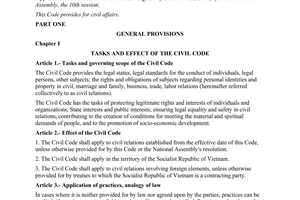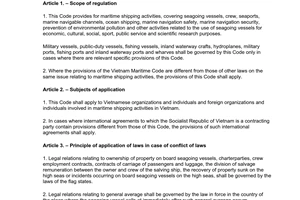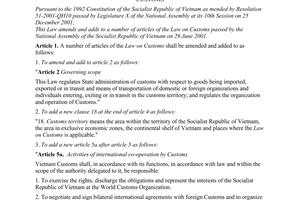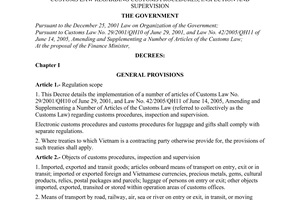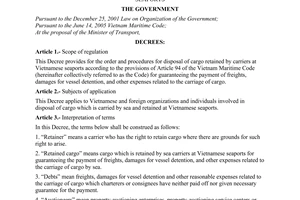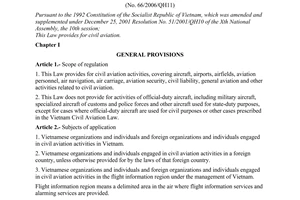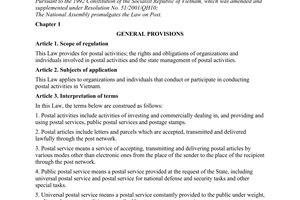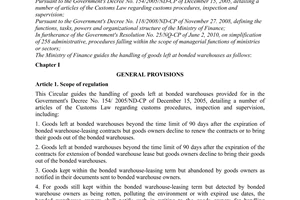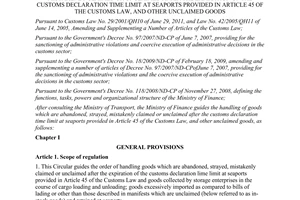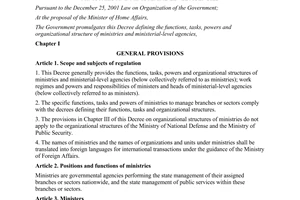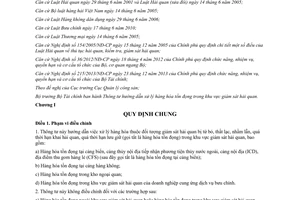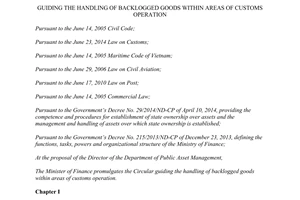Circular No. 15/2014/TT-BTC guidance on handling of goods left in the customs monitoring area đã được thay thế bởi Circular No. 203/2014/TT-BTC handling of backlogged goods within areas of customs operation và được áp dụng kể từ ngày 05/02/2015.
Nội dung toàn văn Circular No. 15/2014/TT-BTC guidance on handling of goods left in the customs monitoring area
|
MINISTRY
OF FINANCE |
SOCIALIST
REPUBLIC OF VIETNAM |
|
No. : 15/2014/TT-BTC |
Hanoi, January 27, 2014 |
CIRCULAR
GUIDANCE ON HANDLING OF GOODS LEFT IN THE CUSTOMS MONITORING AREA
Pursuant to the Civil Code dated June 14, 2005;
Pursuant to the Customs Law dated June 29, 2001 and the Customs Law (amended) dated June 14, 2005;
Pursuant to Vietnam Maritime Code dated June 14, 2005;
Pursuant to the Law on Civil Aviation dated June 29, 2006;
Pursuant to the Postal Law dated June 17, 2010;
Pursuant to the Commercial Law dated June 14, 2005;
Pursuant to Decree No. 154/2005/ND-CP dated December 15, 2005 of the Government detailing a number of articles of the Customs Law regarding the customs procedures, inspection and supervision;
Pursuant to Decree No. 36/2012/ND-CP dated April 18, 2012 of the Government defining the functions, tasks, powers and organizational structures of ministries and ministerial-level agencies;
Pursuant to Decree No. 215/2013/ND-CP December 23, 2013 of the Government defining the functions, tasks, powers and organizational structure of the Ministry of Finance;
At the proposal of Department of public asset management;
The Minister of Finance issues the Circular guiding the handling of goods left in the customs monitoring areas.
Chapter I
GENERAL REGULATION
Article 1. Scope of adjustment
1. This Circular guides the handling of products subject to customs monitoring that are abandoned, lost, confused or exceed the time limit for customs declaration (hereafter referred to as the goods left) in customs monitoring area, including:
a) Goods left at seaport, inland water port receiving foreign water means, inland container depot (ICD), container freight station (CFS) (hereafter referred to as goods left at seaport);
b) Goods left at airport;
c) Goods left at bonded warehouse;
d) Goods left in customs monitoring area of postal service provider;
2. This Circular is not amended in the following cases:
a) Goods left outside the customs monitoring area or left in the customs monitoring area but not subject to customs monitoring;
b) Goods left subject to confiscation and expropriation for state funds under administrative procedures or criminal remedy;
c) Goods stored at Vietnamese seaport by the carrier shall be handled under Decree No. 46/2006/ND-CP dated May 16, 2006 of the Government;
3. The handling of goods left as the ones temporarily imported for re-exported, transferred through border gate or stored at bonded warehouse must be deposited as prescribed. In addition to compliance with the provisions in this Circular, it is required to comply with guidance of the Ministry of Industry and Trade and the Ministry of Finance on the management and use of trader’s deposit amount;
Article 2. Subjects of application
1. Customs authorities at all levels;
2. Warehouse and open storage business;
3. Carriers, carrier agents, forwarding companies, authorized representatives of carriers, forwarding companies (hereinafter collectively referred to as the carrier);
4. Bonded warehouse owner;
5. Postal service provider;
6. Goods owner as sender or receiver named in the Bill of Lading;
7. Other persons related to the handling of goods left in the customs monitoring area;
Article 3. Principles to manage and handle the goods left in the customs monitoring area
1. The handling of goods left in the customs monitoring area must comply with the time, order and procedures specified in this Circular;
2. The handling of goods left must be timely, open, transparent and in accordance with regulations;
Chapter II
HANDLING OF GOODS LEFT IN THE CUSTOMS MONITORING AREA
Section 1. HANDLING OF GOODS LEFT AT SEAPORT
Article 4. Scope of goods left at seaport
1. Abandoned goods including the goods whose owner has informed in writing of the abandonment or has not come to get them or replied after the competent authorities has notified as prescribed; the goods kept in Vietnam and abandoned at seaport by the carrier who has submitted his/her written abandonment of lien;
2. Goods lost without their receivers including: the goods having receiving address in Vietnam, lost in other countries and brought back to Vietnam; the goods sent to other countries but lost in Vietnam; the goods sent to the wrong receivers in Vietnam;
3. Goods is beyond the time limit for customs declaration and is publicly announced under the provisions in Article 6 of this Circular;
4. Goods are collected by the warehouse and open storage business during the loading and unloading without receiver;
5. Goods imported outside the Bill of lading and manifest without receiver;
Article 5. Monitoring, classification, storage and preservation of goods left in stock
1. Responsibility of warehouse and open storage business:
a) Monitoring, counting and classifying the goods left in stock under the Form 01/HHTD-CB issued together with this Circular;
b) Informing the goods owner or the carrier under the provisions of Clause 2, Article 6 of this Circular;
c) Quarterly informing the managing customs sub-Department (hereafter referred to as customs sub-Department) of the goods left or no later than the 15th date of the first month of subsequent quarter. The scope of goods left notified to the customs sub-Department includes:
c.1) The goods whose owner has informed in writing of the abandonment; the goods kept in Vietnam and abandoned at seaport by the carrier who has submitted his/her written abandonment of lien;
c.2) The goods are lost and other goods are kept at border gate area without receivers after 90 days from the date the goods arrive at the unloading gate;
c.3) The goods are collected by the warehouse and open storage business during the loading and unloading process of without receiver after having performed the notification procedures under the provisions in Clause 2, Article 6 of this Circular;
c.4) The goods are imported outside the Bill of Lading and manifest without receiver in the period;
In case where the time limit for periodic report has not come yet but the warehouse and open storage has detected that the goods eligible for identification as the goods left in stock are perishable goods, frozen goods, hazardous and toxic chemicals and the goods whose expiry date is less than 60 days. The warehouse and open storage business is responsible for notifying the Customs Sub-Department within 02 working days from the date of detection.
d) Providing information related to the batch of goods left in stock upon the requirement of customs authority;
dd) Arranging place of warehouse and open storage to ensure the satisfaction of customs monitoring conditions for storage and preservation of goods left in stock during the time of awaiting the handling;
2. Responsibility of carrier:
a) Within 05 working days, from the 91st day when the goods arrive at the unloading gate without any receiver, the carrier shall notify the Customs Sub-Department of unloading border gate of the list of Bill of lading exceeding 90 days, from the date the goods arrive at the unloading border gate without any receiver under the Form 01/HHTD-CB issued together with this Circular and with documents notifying the goods have arrived at the border gate;
b) Providing information related to the batch of goods left in stock upon the requirement of customs authorities;
3. Responsibility of customs Sub-Department:
a) Based on the notification of the warehouse and open storage business and the carrier, the customs Sub-Department shall inspect and verify the goods left in stock under the pprovisions in Article 6 of this Circular;
b) Conducting the notification procedures under the provisions in Article 6 of this Circular;
Article 6. Notification procedures
1. For the goods left in stock stipulated in Clause 2 and 3, Article 4 of this Circular;
a) Within 05 working days, from the date of receiving the notification of warehouse and open storage business of the goods left in stock, the customs Sub-Department shall give information about the goods left as follows:
- Publishing on customs newspaper for 03 consecutive issues;
- Publishing on the customs web portal and webpage on state assets;
- Publicly posting at the Customs Department and Customs Sub-Department;
b) The time limit for notification to the receiver is 180 days from the date of first notification. In case where the time limit under the Customs Law (amended) has changed, the time limit for notification is done under the provisions of the Customs Law (amended);
For perishable goods, frozen goods, hazardous and toxic chemicals and the goods whose expiry date is less than 60 days, the time limit for notification to the receiver is 30 days, from the date of first notification;
2. For the goods that are collected during the loading and unloading process and kept by the warehouse and open storage business without any receiver;
a) Within 15 days, from the date the goods arrive at the unloading border gate, the warehouse and open storage business shall notify in writing the goods owner (the receiver names on the Bill of Lading)/ the carrier for receiving under the Form No. 03/TB-KB issued together with this Circular. If exceeding 15 days, from the date of first notification but without receiver, the warehouse and open storage business shall notify for the second time in writing the goods owners/carrier. The notification is sent by registered mail through the recorded delivery. The time limit for the goods owner/carrier to come and receive the goods is 30 days, from the date of first notification;
b) In case of failing to identify the goods owner/carrier, the warehouse and open storage business shall not notify as stipulated at Point a of this Clause;
3. Within the time limit for receipt of goods as notified, if the goods owner/carrier comes to receive the goods, he/she may go through the import procedures and pay fines due to the slow customs procedures as prescribed by law on sanctions administrative violations in the customs area and the costs incurred due to the delay in receipt of goods. Where the registration of declaration is made at other customs Sub-Department, this customs Sub-Department must give a written notice to the customs Sub-Department managing the goods left for monitoring and performing the next procedures.
4. In case of exceeding the time limit for receiving goods under notification as stipulated in Clause 1 and 2 of this Article without any receiver, the customs Sub-Department shall report to the Head of customs Department for handling under the guidance in Article 7 of this Circular;
5. Cases where the notification is not required:
a) The goods whose owner has informed in writing of the abandonment; the goods kept in Vietnam and abandoned at seaport by the carrier who has submitted his/her written abandonment of lien; the goods imported outside Bill of Lading and manifest without any receiver;
b) The customs authorities have identified that the goods are in the list of goods banned from export, import, temporary export or import under the provisions in Clause 6 of this Article;
6. For the batches of goods left at seaport have signs of violation of law, within 15 days, from the date of receipt of the warehouse and open storage business, the customs Sub-Department shall inspect, verify and determine the actual goods. If after the inspection, verification, the goods are detected to be in the list banned from export, import, temporary export or import, the customs Sub-Department shall handle as prescribed by law without notification as stipulated in this Article. If after the inspection and verification, the goods are not in the list banned from export, import, temporary export or import, the customs Sub-Department shall seal the goods and assign them to the warehouse and open storage business for preservation during the time of notification procedures as prescribed in this Article;
The warehouse and open storage business and the carrier are responsible for introducing the goods left to the customs authorities for inspection and verification as prescribed;
Article 7. Handling Council of goods left at seaport
1. Within 05 working days, from the date of expiry of time limit for coming to receive the goods under notification as stipulated in Article 6 of this Circular or from the date the goods owner/carrier has abandoned them in writing. The customs Sub-Department has the goods left shall report to the Director of Customs Department to decide upon the establishment of handling Council of goods left at seaport (hereafter referred to as Council);
Within 05 working days, from the date of receiving the report from the customs Sub-Department, the Director of Customs Department shall decide upon the establishment of Council under the Form No. 01/QD-HD issued together with this Circular;
2. The Council consists of:
a) Chairman of Council: Leader of Customs Department;
b) Members:
- Leader of custom Sub-Department;
- Leader of professional division of Customs Department;
- Representative of Service of Finance of provinces and centrally-affiliated cities where there are the goods left;
- Representatives of warehouse and open storage business;
- Carrier’s representative (if needed);
- Representative of specialized management organs (if needed);
In case of necessity, the Chairman of Council shall invite the representative of Ministry of Finance (Department of public asset management, General Department of Customs) to participate in the Council in order to settle complex issues;
3. Based on the quantity and nature of goods left and handling tasks, the customs Sub-Department shall request Director of Customs Department to decide upon the number and composition of Council. The Council has the right to use the seal of Customs Department to implement its tasks and is dissolved by itself after completion of tasks;
4. Based on the actual situation of goods left at the customs monitoring area managed by the unit, the Director of Customs Department may establish the standing Council to handle the goods left annually;
5. During the implementation of tasks, the Council is permitted:
a) To establish specialized divisions to assist the Council (counting, classifying the goods left, the Council secretary,…);
b) Hire the functional organizations and individuals to perform the inspection, valuation, disposal or auction of goods left;
c) Hire experts in specialized areas;
6. Chairman of handling Council of goods left shall:
a) Assign tasks to the member Council;
b) Decide to establish professional divisions to assist the Council;
c) Decide the plan and the time to handle the goods left;
d) Manage the Council meetings;
dd) The Council’s representative sign contract to hire the organizations and individuals to provide services during the handling of goods left; sign goods sale contract with the asset buyer;
e) Prepare the estimate for the handling of goods left under the provisions in this Circular;
7. Council’s operation principles:
a) The Council works on the principle of collective. The meetings of the Council shall be convened by the Chairman and there must be at least 2/3 of the total number of Council members attend the meetings;
b) The Council shall discuss and vote on the price and the plan for handling of goods left. The decision on price and plan must be approved by more than half of Council members. In case of equal voting, the Chairman shall decide by casting his/her vote;
c) The Council must record the counting, classification, valuation and propose the plan for handling of goods left;
d) The main contents of record include: Full name of persons handling the goods left; time and place; result of counting, classification and valuation of goods left; opinions of Council members and the persons participating in the meetings on the price and plan for handling of goods left; result of voting; time and place of completion of counting, classification and valuation of goods left; signature of Council members;
Article 8. Counting, classification and valuation of goods left
Within 15 days, from the date of establishment (or 15 days from the date of receipt of report and proposal for handling of goods left in stock from the customs Sub-Department to the Customs Departments establishing the standing Council). The Council shall perform the following tasks:
1. Opening the goods seal or container seal (if any);
2. Counting and classifying the goods left in stock;
3. Valuating the goods left in stock;
4. Making a detailed list of goods left in stock under the Form 02/TH-HĐ;
5. Delivering the goods left in stock to the warehouse and open storage business for handling;
Article 9. Establishing the state ownership
1. Within 05 working days, after the completion of counting, classification and valuation under the provisions in Article 8 of this Circular, the Council shall prepare dossier and report to the Director of Customs Department to establish the state ownership for the goods left under the Form No. 02/QD-XL issued together with this Circular and the plan for handling of goods left under the provisions in Article 10 of this Circular.
The requesting dossier includes:
a) Written request for establishment of state ownership: 01 original;
b) Detailed list of goods left in stock: 01 original;
c) Written request for notification sent to Customs newspaper, customs web portal and webpage on state assets concerning the batch of goods or the notification of warehouse and open storage business to the goods owner/carrier: 01 copy of each request or notification;
d) Written notification of abandonment of goods or documents evidencing the abandonment of goods of the goods owner or the carrier (if any): 01 original;
The copies must be certified and sealed by the Council Chairman;
2. Within 05 working days, after fully receiving dossier to request the handling from the Council, the Director of Customs Department issues the Decision to establish the state ownership over the goods left at seaport;
Article 10. Preparing and approving the plan for handling of goods left in stock
1. Within 05 working days, from the date of completion of counting, classification and valuation under the provisions in Article 8 of this Circular, the Council shall make a plan for handling of goods left in stock in the forms specified in Clause 2 of this Article and submit it to the Director of Customs Department;
2. Form of handling of goods left in stock:
a) Transferring them to the specialized state management authorities to manage and handle goods of cultural and historical value, national treasures, antiques, rare and precious forestry goods, weapons, supporting tools and other assets related to national defense and security;
b) Transferring them to the state organs, public non-business units, people’s armed forces, political organizations, social-political organizations for management and use of usable goods which are means of transportation, machinery, equipment and working facilities and laboratory equipment under the standards, norms and regulations stipulated by the competent state organs;
c) Destroying the goods which are of no longer usable value (decayed, broken, damaged, deteriorated, expired or quality not assured for use causing harm to human, animal and plant health) or subject to destruction under regulations of Vietnam’s law. In special cases, the handling is done in other forms to ensure thrift and efficiency, the Customs Department shall report it to the General Department of Customs to coordinate with the Department of public asset management for submission to the Minister of Finance for consideration and decision;
d) Directly selling (not through auction) in the following cases:
- Food which is fresh and prone to rancidity, difficult to preserve and the goods which are flammable (gasoline, gas oil, liquefied petroleum gas and other flammable substances);
- Processed food but its expiry date is less than 30 days;
- Treating medicines and veterinary medicines whose expiry date is less than 60 days;
- Other types of goods if not handled immediately will be damaged or expired;
- The goods is valued less than 50 million dong/batch according to the Council’s valuation;
dd) Auctioning the goods which are not within the scope specified at Point a, c and d of this Clause and the assets specified at Point b of this Clause but not processed in the form of transfer.
3. Within 05 working days, from the date the handling Council has submitted the plan for handling of goods left, the Director of Customs Department shall decide the plan for handling of goods left under the Form No. 03/QD-PA issued together with this Circular under the authority or report to the General Department of Customs in order to coordinate with the Department of public asset managementfor submission to the Minister of Finance for decision in case of transfer as stipulated at Point a and b, Clause 2 of this Article;
4. For the goods which are required with the state’s special management, the Customs Department shall report to the General Department of Customs to coordinate with the Department of public asset management to report to the Ministry of Finance for submission to the Prime Minister for consideration and decision on form of handling. Based on the Prime Minister’s decision, the Prime Minister shall conduct the handling as prescribed;
Article 11. Handling of goods left in stock
Within 45 days, from the date the competent authorities have decided the plan for handling of goods left in stock, the Council must finish the handling in accordance with the following regulations:
1. For the goods subject to destruction:
a) The Council shall carry out the destruction or hire functional organizations to carry out the destruction which must be recorded;
The main contents of destruction Record include: the grounds for destruction, time, place and participants of destruction, name, type, quantity and conditions of goods at the time of destruction, form of destruction and other relevant contents;
b) Form of destruction:
Depending on the nature and characteristics of goods and materials and environmentalsanitation requirement, the destruction is done in the forms as follows:
- Use of chemicals;
- Use mechanical methods;
- Burning;
- Burial;
- Other forms as prescribed by law;
c) For the goods whose destruction affect the environment must be approved and guided by the local environmental management organs before destruction;
2. For the goods transferred to the specialized management organs for management, handling or transferred to organs, organizations or units for management or use, the Council shall hand over the assets to the receiving unit under the decision of the competent authorities. The handover and receipt of assets are recorded. The main contents of record include: participants of delivery, name, type, quantity and condition, value of assets transferred (if any) and relevant contents;
For the goods which are handled by the method of transfer, record the revenue of central budget when deciding the establishment of state ownership and plan for handling; record the expenditure of central budget upon transfer to the organs, organizations and units.The value of goods upon record of revenue or expenditure of budget is the price determined by the Council;
3. For the goods to be directly sold (not through auction):
On the basis of the value of goods determined, the Council shall publish the information on the sale of goods at the head office of customs Sub-Department and customs Department within 03 days. In case where there are a lot of organizations and individuals registering their purchase, the Council shall hold the casting lots among organizations and individuals to identify the purchaser. The casting of lots is done by the Council in the presence of the persons registering the purchase of goods; the registering persons failing to attend the casting lots shall lose their right to purchase the goods. The casting lots to identify the goods purchaser must be recorded with the signature of the Council Chairman and representative of registering persons. The handling Council is responsible for the publicity and transparency of the casting lots and selection of goods purchaser;
The sale of goods must be made into Contract of sale of goods left. The main contents of Contract include: grounds for sale, time and place of sale, seller, type, quantity, condition of goods at the time of sale, unit price, payment value, purchaser and other relevant contents;
4. For the goods to be auctioned:
a) The starting price for the auction is the one determined by the handling Council (including taxes and fees as prescribed);
b) The Council shall hire a professional auctioning organization to carry out the auction of goods left. In case of failing to hire a professional auctioning organization, the Council Chairman shall invite the representatives of Service of Justice of provinces and centrally-affiliated cities having the goods left to participate in the Council to hold the auction of goods left;
c) Order and procedures for auction of goods left shall comply with regulations of law on auction of assets;
5. The persons who are successful in purchasing the goods specified in Clause 3 and 4 of this Article shall make the payment of purchase of goods to the Council without import procedures and taxes and fees related to the import;
6. In case of direct sale, the purchaser shall make payment within 03 working days, from the date of contract signing. After this time limit, if the purchaser does not make payment or after 15 days, from the date of payment made but the purchaser does not come to receive the goods or does not bring his/her goods out of the customs monitoring area without plausible reasons, the Council shall re-announce the sale of goods as stipulated in Clause 3 of this Article in order to choose the goods purchasers (in case where the purchaser does not make payment and is the unique purchaser) or hold the casting lots among the remaining registering organizations and individuals to choose the next purchaser (in case of first sale with a lot of persons registering to purchase the goods). The amount of money paid by the purchaser shall be managed under the provisions in Chapter III of this Circular and not be refunded to the purchaser;
In case of auction, the person who wins the auction shall make payment of goods purchased and bring the goods out of the customs monitoring area within 15 working days, from the date of contract signing. After this time limit, if the person who wins the auction does not make payment or does not come to receive or not bring the goods out of the customs monitoring area without plausible reasons, the Council shall hold an auction again as stipulated in Clause 4 of this Article. The deposit and the amount of money paid (if any) shall be managed under the provsions in Chapter III of this Circular and not refunded to the purchaser;
7. After the purchaser of goods left as stipulated in Clause 3 and 4 of this Article has made payment and brought the goods out of the customs area, the Council shall provide documents for the purchaser, including:
a) Invoice of selling assets confiscated and expropriated for the state fund under the Form No. 01/TSSQ-3L04 issued together with Decision No. 12/2004/QD-BTC dated January 09, 2004 of the Minister of Finance: 01 original;
b) Contract of sale of goods left (in case of direct sale) or contract of sale of auctioned assets (in case of auction): 01 original;
c) Issue voucher of the warehouse and open storage business: 01 original;
Section 2. HANDLING OF GOODS LEFT AT AIRPORT
Article 12. Scope of goods left at airport
1. Abandoned goods are the ones whose owner has informed in writing of the abandonment or does not come to receive them or not reply after being notified by the warehouse and open storage business at the airport;
2. Goods lost without receiver, including: the goods having the receiving address in Vietnam, being lost in other countries and then brought back to Vietnam; sent to other countries but lost in Vietnam; sent to the wrong receiver in Vietnam;
3. Hand luggage or objects forgotten by air passengers at airport terminals, check-in counter, boarding lounge or on the plane without receiver.
4. Goods are collected by the warehouse and open storage business during the loading and unloading without receiver;
5. Goods imported outside the Bill of lading and manifest without receiver;
Article 13. Annoucement of goods left at airport
1. Within 05 days, from the date of detection of goods left, the warehouse and open storage business at airport shall notify in writing the goods owner to receive them or make a list at airport in case of failing to identify the owner of the goods. In case of form of notification, exceeding 15 days, from the date of first notification without receiver, the warehouse and open storage business shall notify in writing the goods owner for the second time. The notification is sent by registered mail through the recorded delivery. The time limit for the goods owner to come and receive the goods is 60 days, from the date of first notification or listing;
2. Quarterly, no later than the 15th date of the first month of subsequent quarter, the warehouse and open storage business shall notify the customs Sub-Department of the situation of goods left at airport under the Form No. 02/HHTD-HK issued together with this Circular and prepare documents to request the handling of goods left for submission to the customs Sub-Department under the provisions of Article 14 of this Circular;
3. Scope of goods left notified the customs Sub-Department includes:
a) The goods whose owner has informed in writing of the abandonment;
b) The goods are lost without receiver after 60 days, from the date of notification;
c) Hand luggage or objects forgotten by air passengers at airport terminals, check-in counter, boarding lounge or on the plane without receiver after 30 days, from the date of notification;
d) The goods are collected by the warehouse and open storage business during the loading and unloading process of without receiver after having performed the listing or notification procedures under the provisions in Clause 1 of this Article;
dd) The goods are imported outside the Bill of Lading and manifest without receiver in the period;
4. In case where the time limit for periodic report has not come yet but the warehouse and open storage has detected that the goods eligible for identification as the goods left in stock are perishable goods, frozen goods, hazardous and toxic chemicals and the goods whose expiry date is less than 60 days. The warehouse and open storage business is responsible for preparing dossier within 02 working days, from the date of detection, for submission to the customs Sub-Department.
Article 14. Dossier to request the handling of goods left at airport
1. The dossier to request the handling of goods left at airport is made into two (02) sets; one (01) set is sent to the customs Sub-Department, one (01) set is kept at the warehouse and open storage business;
2. The dossier includes:
a) Written request for handling of goods left in stock from the warehouse and open storage business: 01 original;
b) Notifications sent from the warehouse and open storage business to the goods owner (if any) or notification posted at airport: 01 copy
c) Written abandonment of goods of the goods owner (if any): 01 copy;
d) List of quantity, type and specifications of goods left: 01 original;
dd) Other dossier and documents related to the goods left in stock: 01 copy;
All of the copies must be signed for certification and affixed with the seal of the warehouse and open storage business;
Article 15. Handling Council of goods left at airport
1. The handling Council of goods left at airport (hereafter referred to as the Council) consists of:
a) Council Chairman: Leader of Customs Department;
b) Members:
- Leader of Customs Sub-Department;
- Leader of professional division of Customs Department;
- Representative of Service of Finance of provinces and centrally-affiliated cities where there are the goods left;
- Representatives of warehouse and open storage business;
- Carrier’s representative (if needed);
- Representative of specialized management organs (if any);
In case of necessity, the Chairman of Council shall invite the representative of Ministry of Finance (Department of public asset management, General Department of Customs) to participate in the Council in order to settle complex issues;
2. The establishment, operation principles of Council and responsibility of Council Chairman shall comply with the provisions in Clauses 1, 3, 4, 5, 6 and 7 and Article 7 of this Circular;
Article 16. Handling of goods left at airport
1. The counting, classification, valuation, preparation and approval for plan for handling and implementation of handling of goods left at airport shall comply with the provisions in Articles 8, 10 and 11 of this Circular;
2. When selling the goods left at airport, after the purchaser has paid and brought the goods out of the customs monitoring area, the Council shall provide documents for the purchaser, including:
a) Invoice of selling assets confiscated and expropriated for the state fund under the Form No. 01/TSSQ-3L04 issued together with Decision No. 12/2004/QD-BTC dated January 09, 2004 of the Minister of Finance: 01 original;
b) Contract of sale of goods left (in case of direct sale) or contract of sale of auctioned assets (in case of auction): 01 original;
c) Issue voucher of the warehouse and open storage business: 01 original;
3. The persons who are successful in purchasing the goods left at airport shall not have to go through the import procedures and pay taxes and fees related to the import;
Article 17. Establishing the state ownership for the goods left at airport
1. Within 05 working days, from the date of expiry for the goods owner to come and receive the remaining amount of money from the handling of goods left (180 days) without receiver, the Director of Customs Department shall decide the establishment of state ownership for the goods left under the Form No. 02/QD-XL issued together with this Circular;
2. The amount of money from the sale of goods left established with the state ownership is managed and used under the provisions of Article 30 of this Circular;
Section 3. HANDLING OF GOODS LEFT IN BONDED WAREHOUSE
Article 18. Scope of goods left in bonded warehouse
1. The goods are left in bonded warehouse exceeding the time limit of 90 days, from the expiry date of bonded warehouse lease contract but the goods owner does not sign the contract renewal or bring the goods out of the bonded warehouse;
2. The goods whose bonded warehouse lease contract renewal is expired but the goods owner has not brought his/her goods out of the bonded warehouse;
3. The goods are within the term of bonded warehouse lease contract but the goods owner has sent a written abandonment of goods to the bonded warehouse;
4. For the goods which are within the term of bonded warehouse lease contract but the bonded warehouse owner detects those goods are damaged causing environmental pollution or are expired, he/she shall give a written notice to the goods owner for handling as prescribed and under the bonded warehouse lease contract. In case of exceeding the time limit for handling as notified but the goods owner has not carried out the handling, those goods shall be handled under the provisions of this Section;
Article 19. Notification of the goods stored in bonded warehouse
1. Within 15 days prior to the expiry date of bonded warehouse contract or contract renewal, the bonded warehouse owner shall give a written notice to the goods owner and the customs Sub-Department of the incoming expiry date of bonded warehouse contract or contract renewal;
2. Quarterly, no later than the 15th date of the first month of the subsequent quarter, the bonded warehouse owner shall report to the customs Sub-Department of the situation of goods left in the bonded warehouse under the Form No. 04/HHTD-NQ issued together with this Circular. In case of goods left in stock as stipulated in Article 18 of this Circular, the bonded warehouse owner shall prepare dossier to request the handling of goods left in bonded warehouse for submission to the customs Sub-Department for handling;
In case where the time limit for periodic report has not come yet but the bonded warehouse owner has detected that the goods eligible for identification as the goods left in stock are perishable goods, frozen goods, hazardous and toxic chemicals and the goods whose expiry date is less than 60 days, the bonded warehouse owner shall prepare dossier within 02 working days from the date of detection for submission to the customs Sub-Department managing the bonded warehouse;
Article 20. Dossier to request the handling of goods left in bonded warehouse
1. The dossier to request the handling of goods left in bonded warehouse is made into two (02) sets; one (01) set is sent to the customs Sub-Department managing the bonded warehouse and one (01) set is kept at the bonded warehouse;
2. The dossier to request the handling of goods left in bonded warehouse includes:
a) Written request for handling of goods left in bonded warehouse from the bonded warehouse owner is sent to the customs Sub-Department managing the bonded warehouse: 01 original;
b) Bonded warehouse lease contract and contract renewal (if any): 01 copy;
c) Notifications sent from the bonded warehouse owner to the goods owner (if any): 01 copy;
d) Goods owner’s written abandonment of goods left in bonded warehouse (if any): 01 copy;
dd) List of quantity, type, specification of goods left in bonded warehouse, warehouse contract number, number/date of entry/exit declaration of of bonded warehouse: 01 original;
e) Other dossier and documents related to the goods left in stock in bonded warehouse: 01 copy;
The copies must be signed for certification and affixed with seal of bonded warehouse owner
Article 21. Handling Council of goods left in bonded warehouse
1. The handling Council of goods left in bonded warehouse consists of:
a) Council Chairman: Leader of Customs Department;
b) Members:
- Leader of customs Sub-Department;
- Leader of professional division of Customs Department;
- Bonded warehouse owner or his/her authorized person;
- Representatives of Service of Finance of provinces and centrally-affiliated cities (where the bonded warehouse is located);
- Representative of units concerned (if needed);
In case of necessity, the Chairman of Council shall invite the representative of Ministry of Finance (Department of public asset management, General Department of Customs) to participate in the Council in order to settle complex issues;
2. The establishment, operation principles of Council and responsibility of Council Chairman shall comply with the provisions in Clauses 1, 3, 4, 5, 6 and 7 and Article 7 of this Circular;
Article 22. Establishing the state ownership for the goods left in bonded warehouse
1. Within 05 working days, from the date of completion of counting, classification, the Council shall prepare a report attached to dossier specified in Clause 2, Article 20 of this Circular for submission to the Director of Customs Department for decision on the state ownership for the goods left in stock;
2. Within 05 working days, from the date of fully receiving dossier specified in Clause 1 of this Article, the Director of Customs Department shall decide upon the establishment of state ownership under the Form No. 02/QD-XL issued together with this Circular;
Article 23. Handling of goods left in bonded warehouse
1. The counting, classification, valuation, preparation and approval for plan for handling and implementation of handling of goods left in bonded warehouse shall comply with the provisions in Articles 8, 10 and 11 of this Circular;
2. When selling the goods left in the bonded warehouse, after the purchaser has paid and brought the goods out of the customs monitoring area, the Council shall provide documents for the purchaser, including:
a) Invoice of selling assets confiscated and expropriated for the state fund under the Form No. 01/TSSQ-3L04 issued together with Decision No. 12/2004/QD-BTC dated January 09, 2004 of the Minister of Finance: 01 original;
b) Contract of sale of goods left (in case of direct sale) or contract of sale of auctioned assets (in case of auction): 01 original;
c) Issue voucher of the owner of bonded warehouse: 01 original;
3. The persons who are successful in purchasing the goods left in bonded warehouse shall not have to go through the import procedures and pay taxes and fees related to the import;
Section 4. HANDLING OF GOODS LEFT AT POSTAL SERVICE PROVIDER IN CUSTOMS MONITORING AREA
Article 24. Scope of goods left of postal service provider in customs monitoring area
1. The imported goods are sent through the postal service provider but have not been gone through customs procedures but the goods owner notifies in writing the abandonment or does not come to receive them nor replies after having been notified by the postal service provider;
2. The goods are sent through the postal service provider with their completion of export procedures but cannot be delivered to the receiver and the goods owner notifies in writing the abandonment or does not come to receive them nor replies after having been notified by the postal service provider;
Article 25. Notification of goods left at postal service provider
1. Within 05 days, from the date of detection of goods left, the postal service provider shall notify in writing the goods owner to receive. In case of exceeding 15 days, from the date of first notification without receiver, the postal service provider shall notify in writing the goods owner for the second time. The notification is sent by registered mail through the recorded delivery. The time limit for the goods owner to come and receive the goods is 90 days, from the date of first notification or listing;
2. Quarterly, no later than the 15th date of the first month of subsequent quarter, the postal service provider shall notify the customs Sub-Department of the situation of goods left under the Form No. 06/HHTD-HK issued together with this Circular. In case of goods left as stipulated in Article 24 of this Circular, the postal service provider shall prepare dossier to request the handling of goods left for submission to the customs Sub-Department for handling;
In case where the time limit for periodic report has not come yet but the postal service provider has detected that the goods eligible for identification as the goods left in stock are perishable goods, frozen goods, hazardous and toxic chemicals and the goods whose expiry date is less than 60 days. The postal service provider is responsible for notifying the Customs Sub-Department within 02 working days from the date of detection.
Article 26. Dossier to request the handling of goods left in stock
1. The dossier to request the handling of goods left at the postal service provider is made into two (02) sets; one (01) set is sent to the customs Sub-Department, one (01) set is kept at the postal service provider;
2. Dossier to request the handling includes:
a) Written request for handling of goods left in stock from the postal service provider sent to the customs Sub-Department: 01 original;
b) Notifications sent from the postal service provider to the goods owner (if any): 01 copy;
c) Written abandonment of goods of the goods owner (if any): 01 copy;
d) List of quantity, type and specifications of goods left: 01 original;
dd) Other dossier and documents related to the goods left in stock: 01 copy;
All of the copies must be signed for certification and affixed with the seal of the postal service provider;
Article 27. Handling Council of goods left at the postal service provider
1. The handling Council of goods left at the postal service provider (hereafter referred to as Council) consists of:
a) Council Chairman: Leader of Customs Department;
b) Members:
- Leader of Customs Sub-Department;
- Leader of professional division of Customs Department;
- Representative of Service of Finance of provinces and cities where there are the goods left in stock;
- Representative of the postal service provider;
- Representative of specialized management organ (if needed);
In case of necessity, the Chairman of Council shall invite the representative of Ministry of Finance (Department of public asset management, General Department of Customs) to participate in the Council in order to settle complex issues;
2. The establishment, operation principles of Council and responsibility of Council Chairman shall comply with the provisions in Clauses 1, 3, 4, 5, 6 and 7 and Article 7 of this Circular;
Article 28. Establishing the state ownership for the goods left at the postal service provider
1. Within 05 working days, from the date of completion of counting, classification, the handling Council shall prepare a report attached to dossier specified in Article 26 of this Circular for submission to the Director of Custom Department for establishment of state ownership of assets;
2. Within 05 working days, from the date of fully receiving dossier specified in Clause 1 of this Article, the Director of Custom Department shall make a decision on establishment of state ownership under the Form No. 02/QD-XL issued together with this Circular;
Article 29. Handling of goods left at the postal service provider
1. The counting, classification, valuation, preparation and approval for plan for handling and implementation of handling of goods left at the postal service provider shall comply with the provisions in Articles 8, 10 and 11 of this Circular;
2. When selling the goods left at the postal service provider, after the purchaser has paid and brought the goods out of the customs monitoring area, the Council shall provide documents for the purchaser, including:
a) Invoice of selling assets confiscated and expropriated for the state fund under the Form No. 01/TSSQ-3L04 issued together with Decision No. 12/2004/QD-BTC dated January 09, 2004 of the Minister of Finance: 01 original;
b) Contract of sale of goods left in stock (in case of direct sale) or contract of sale of auctioned assets (in case of auction): 01 original;
c) Issue voucher of the postal service provider: 01 original;
3. The persons who are successful in purchasing the goods left at the postal service provider shall not have to go through the import procedures and pay taxes and fees related to the import;
Chapter III
FINANCIAL MANAGEMENT
Article 30. of the proceeds from the handling of goods left in stock
1. The proceeds from the handling of goods left in stock include:
a) Proceeds from selling goods left in stock;
b) Deposit and amount of money the goods purchaser has paid but he/she did not come to receive the goods or bring them out of the customs monitoring area;
2. For the proceeds from the handling of goods left at seaport, bonded warehouse and postal service provider:
All of the proceeds from the sale of goods left at seaport, bonded warehouse and postal service provider established with the state ownership are paid into the the Ministry of Finance’s imprest account opened at the state treasury;
Quarterly (no later than the 20th date of the first month of subsequent quarter), the proceeds from the sale of goods left at seaport, bonded warehouse and postal service provider on the imprest account, after deducting the costs specified in Article 31 of this Circular, shall be paid into the central budget. All of the proceeds from the sale of goods left in stock shall be finalized annually (prior to the 31st date of March of subsequent year);
3. For the proceeds from the handling of goods left at airport:
The proceeds from the handling of goods left at airport shall be paid into the Customs Department’s imprest account opened at the state treasury;
After deducting the costs specified in Article 31 of this Circular, the remaining amount (if any) shall be returned to the goods owner. When receiving the amount of money from the sale of goods left in stock, the goods owner must pay taxes as prescribed by law (if any). Upon the expiration of 180 days, from the date of sale of goods left in stock but the goods owner has not come to receive the remaining amount of money, the Customs Department shall report to the Director of Customs Department to make a decision on establishment of state ownership of assets as stipulated in Article 17 of this Circular and pay the remaining amount of money into the central budget;
Article 31. Contents of expenditure
1. Expenditure for counting and classification of goods;
2. Expenditure for inspection and valuation of goods;
3. Expenditure for publishing information on goods left in stock;
4. Expenditure for stationery, printing, documentation photocopying;
5. Auction fee (in case of hiring professional auctioning organizations);
6. Cost of loading and unloading, lifting and lowering of goods, warehouse and open storage, bonded warehouse services (if any).
All of the costs of warehouse and open storage, bonded warehouse before the date the Director of Customs Department makes a decision on establishment of state ownership shall be paid by the goods owner; in case where the goods owner abandons, denies or does not make payment, the warehouse and open storage business, the bonded warehouse owner and the postal service provider may record in the costs of businesses;
7. Expenditure for allowance to members of handling Council and assistance Team during the handling of goods left in stock (counting, classification, inspection, valuation, plan preparation and goods sale);
8. Cost of goods transportation for the handling of goods;
9. Cost of destruction of goods (including costs related to the treatment of environment upon destruction);
Article 32. Rate of expenditure
1. For expenditures with norm, standard and unit price regulated by the competent state authorities, the current regulations shall apply;
2. Expenditure for allowance to members of handling Council and assistance Team during the handling of goods left in stock at the rate not exceeding VND 100,000 / person / day. The payment date is the actual number of days the members perform the tasks of handling Council and the assistance Team.
3. Expenditure for printing, documentation photocopying, stationery, gasoline, logistics services and other services for the management apparatus is calculated according to the actual needs of each particular case.
4. For the expenditures specified in Article 31 of this Circular not subject to the scope specified in Clauses 1, 2 and 3 of this Article, the Director of Customs Department shall decide upon the expenditure on the basis of actual costs incurred and contract with the services provider (if any) and funding capacity for handling of goods left in stock at the same time take responsibility for his/her decision;
Article 33. Source of fund
1. The source of fund for expenditure is used from the proceeds of sale of goods left in stock paid into the imprest account opened at the state treasury;
2. Where the proceeds from the sale of assets of one time of handling are not sufficient for payment of costs but the balance of previous handlings is still in the imprest account. The amount of money on the imprest account may be used to support the payment of costs. If still insufficient, request the support from the central budget under current regulation;
3. Where there is no source of fund for payment, the Council shall advance funds from the imprest account and estimates of recurrent expenditure budget of the Customs Department or the warehouse and open storage business, the bonded warehouse owner and the postal service provider for payment. The advanced amount is refunded from the source of funds specified in Clause 2 of this Article;
4. For the goods temporarily for re-exported, transferred through border gate or stored at bonded warehouse must be deposited as prescribed, the payment of expenditures shall comply with the guidance of the Ministry of Industry and Trade and the Ministry of Finance;
Chapter IV
IMPLEMENTATION PROVISION
Article 34. Transitional provision
1. For the goods left in stock before the effective date of this Circular but the competent authorities have established the handling Council, the handling of goods left in stock shall apply under the regulations of law before the effective date of this Circular;
2. For the goods left in stock from the effective date of this Circular without establishment of handling Council, the provisions on handling in this Circular shall apply;
Article 35. Effect
1. This Circular takes effect on March 15, 2014;
2. This Circular annuls the following documents:
a) Circular No. 33/2004/TT-BTC dated April 15, 2004 of the Ministry of Finance guiding the handling of goods, luggage and assets left in stock without receiver at Vietnamese airports;
b) Circular No. 195/2010/TT-BTC dated December 06, 2010 of the Ministry of Finance guiding the handling of goods left in bonded warehouse;
c) Circular No. 179/2011/TT-BTC dated December 08, 2011 of the Ministry of Finance guiding the handling of goods which are abandoned, lost, confused or exceed the time limit for customs declaration at seaport without receiver as stipulated in Article 45 of the Customs Law and other goods without receive
3. Any difficulty arising during the implementation of this Circular should be promptly reported to the Ministry of Finance for settlement;
|
|
FOR THE
MINISTER |
Form of Decision No. 01/QĐ-HĐ
|
GENERAL DEPARTMENT OF CUSTOMS |
SOCIALIST
REPUBLIC OF VIETNAM |
|
No.: |
..........,date ... month .... year..... |
DECISION
on establishment of handling Council of goods left in stock
DIRECTOR OF CUSTOMS DEPARTMENT.....
Pursuant to Circular No. 15/2014/TT-BTC dated Janury 27, 2014 of the Ministry of Finance guiding the handling of goods left in the customs monitoring area;
Pursuant to Decision of....defining the functions and duties of....;
Pursuant to documents of organs and units concerned on sending officials and public employees to participate in the handling Council of goods left in stock;
Considering the request of the Head of customs Sub-Department ....;
DECIDES:
Article 1. Establishing the handling Council of goods left at.......Mr/Mrs:.....title:........as the Council Chairman and the members named in the attached list;
Article 2. The handling Council of goods left shall perform duties under the provisions of Circular No. 15/2014/TT-BTC dated January 27, 2014 of the Ministry of Finance guding the handling of goods left in the customs monitoring area and the relevant laws;
The handling Council shall be dissolved by itself after completion of tasks;
Article 3. This Decision takes effect from the signing date. The units and individuals named in the attached list specified in Article 1 are liable to execute this Decision./.
|
|
DIRECTOR OF CUSTOMS DEPARTMENT (Sign and seal) |
Form of Decision No. 02/QD-XL
|
GENERAL DEPARTMENT OF CUSTOMS |
SOCIALIST
REPUBLIC OF VIETNAM |
|
No.: |
..........,date ... month .... year..... |
DECISION
on establishment of state ownership of assets
DIRECTOR OF CUSTOMS DEPARTMENT .....
Pursuant to Circular No. 15/2014/TT-BTC dated Janury 27, 2014 of the Ministry of Finance guiding the handling of goods left in the customs monitoring area;
Pursuant to Decision of....defining the functions and duties of....;
Considering the request of handling Council for the goods left in stock,
DECIDES:
Article 1. Establishing the state ownership for the goods left at ...., including:
|
No. |
Name of goods |
Unit |
Amount/ Quantity |
Condition of goods |
|
|
|
|
|
|
|
|
|
|
|
|
Article 2. This Decision takes effect from the signing date. ............................ (1) are liable to execute this Decision./.
|
|
DIRECTOR OF CUSTOMS DEPARTMENT (Sign and seal) |
(1) Heads of units related to the goods left such as: the Customs Sub-Department, the warehouse and open storage business, the postal service provider, the bonded warehouse owner, expressage business….
Form of Decision No. 03/QĐ-PA
|
GENERAL DEPARTMENT OF CUSTOMS |
SOCIALIST
REPUBLIC OF VIETNAM |
|
No.: |
..........,date ... month .... year..... |
DECISION
on approving the plan for handling of goods left at....
DIRECTOR OF CUSTOMS DEPARTMENT .....
Pursuant to Circular No. 15/2014/TT-BTC dated Janury 27, 2014 of the Ministry of Finance guiding the handling of goods left in the customs monitoring area;
Pursuant to Decision of....defining the functions and duties of....;
Considering the request of handling Council for the goods left in stock;
DECIDES:
Article 1. Approving the plan for handling of goods leftt........ as follows:
|
No. |
Name of goods |
Unit |
Amount/ Quantity |
Condition of goods |
Plan for handling (1) |
|
|
|
|
|
|
|
|
|
|
|
|
|
|
Article 2. The handling Council of goods left shall perform duties under the provisions of Circular No. 15/2014/TT-BTC dated January 27, 2014 of the Ministry of Finance guding the handling of goods left in the customs monitoring area and the relevant laws;
Article 3. This Decision takes effect from the signing date. The handling Council of goods left and the heads of units concerned are liable to execute this Decision./.
|
|
DIRECTOR OF CUSTOMS DEPARTMENT (Sign and seal) |
(1) Specify the plan for handling: transfer, sale (directly or auction), destruction or other plans (if any);
Form No. 01/HHTĐ-CB
|
NAME OF THE WAREHOUSE AND OPEN STORAGE BUSINESS/CARRIER/CARRIER AGENT/FORWARDING BUSINESS |
|
NOTICE OF GOODS LEFT IN STOCK
AT ……………………………
(Data collected from…../…./………… to …./…/……………)
To: Customs Sub-Department …..
|
No. |
Name of goods |
Amount, quantity |
Number, type of container / seal number |
Sender and address |
Receiver and address |
Number/date of B/L |
Spare parts and materials name / date of entry |
Location of goods storage |
Classification of goods left in stock |
Note |
|
(1) |
(2) |
(3) |
|
(4) |
(5) |
(6) |
(7) |
(8) |
(9) |
(10) |
|
|
|
|
|
|
|
|
|
|
|
|
|
|
|
|
|
|
|
|
|
|
|
|
|
|
|
|
|
|
|
|
|
|
|
|
Note: In box No. (9) specify: The goods are lost, abandoned, confused, exceed the time limit for customs declaration, are collected without receiver; the goods are outside Bill of Lading and manifest;
|
|
DIRECTOR (Signature, full name, seal) |
Form No. 02/TH-HQ
|
CUSTOMS SUB-DEPARTMENT OF BORDER GATE.... |
|
DETAILED LIST OF GOODS LEFT IN STOCK
|
No. |
Name of goods |
Amount, quantity |
Number, type of container / seal number |
Sender and address |
Number of days of warehouse/open storage |
Location of goods storage |
Condition of goods |
Classification of goods left in stock |
Official’s entry (signature, full name, date of entry) |
|
(1) |
(2) |
(3) |
(4) |
(5) |
(6) |
(7) |
(8) |
(9) |
(10) |
|
|
|
|
|
|
|
|
|
|
|
|
|
|
|
|
|
|
|
|
|
|
|
|
|
|
|
|
|
|
|
|
|
Note:
- In box No. (9) specify that the goods are lost, abandoned, confused, exceed the time limit for customs declaration, are collected without receiver; the goods are outside Bill of Lading and manifest;
- In box No. (8) specify that some notes on goods (if any) such as perishable goods, frozen goods, chemicals, goods likely to cause environmental pollution, ...
|
|
LEADER OF SUB-DEPARTMENT |
Form No. 03/TB-KB
NAME OF WAREHOUSE AND OPEN STORAGE BUSINESS
NOTICE OF….TIME
|
To: |
- Receiver’s name (if any); - Carrier/Carrier agent/Forwarding company: |
Information on the batch of goods:
+ Name of goods:
+ Amount/quantity:
+ Number, type of container/seal number:
+ Number/date of B/L (if any):
+ Spare parts and materials name / date of entry:
+ Location of goods storage:
+ Name and address of sender:
+ Name and address of receiver:
To date, exceeding 30 days from the date the batch of goods arrives at port…, but Company…(the warehouse and open storage business) has not seen any unit to come and receive it.
Within 30 days from the date of first notification (specify the date of first notification), if there is no unit coming and receiving it, Company…( the warehouse and open storage business) shall deliver the batch of goods to the border gate customs authorities for handling under the provisions in Circular No. 15/2014/TT-BTC dated January 27, 2014 of the Ministry of Finance guiding the handling of goods left in the customs monitoring area;
|
|
DIRECTOR OF WAREHOUSE AND OPEN STORAGE BUSINESS |
Form No. 04/HHTD-NQ
BONDED WAREHOUSE …...
PROVINCE AND CITY……
NOTICE OF GOODS LEFT IN STOCK
at……………………………
(Data collected from …../…./………… to …./…/……………)
To: Customs Sub-Department …..
|
No. |
Name of goods owner |
Name of goods |
Unit |
Amount/quantity of goods |
Number and date of customs declaration |
Number and date of warehouse lease contract |
Condition of goods |
|
(1) |
(2) |
(3) |
(4) |
(5) |
(6) |
(7) |
(8) |
|
|
|
|
|
|
|
|
|
Note:
- In box No. (8) specify that some notes on goods (if any) such as perishable goods, frozen goods, chemicals, goods likely to cause environmental pollution, ...
|
|
DIRECTOR (Signature, full name and seal) |
Form No. 05/HHTD-HK
|
NAME OF WAREHOUSE AND OPEN STORAGE BUSINESS |
|
NOTICE OF GOODS LEFT IN STOCK
AT ……………………………
(Data collected from …../…./………… to …./…/……………)
To: Customs Sub-Department …..
|
No. |
Name of goods owner |
Name of goods |
Unit |
Amount/ Quantity |
Receiver/address |
Number/date of B/L |
Condition of goods |
Note |
|
(1) |
(2) |
(3) |
|
(4) |
(5) |
(6) |
(7) |
(8) |
|
|
|
|
|
|
|
|
|
|
|
|
|
|
|
|
|
|
|
|
|
|
|
|
|
|
|
|
|
|
Note:
- In box No. (7) specify that some notes on goods (if any) such as perishable goods, frozen goods, chemicals, goods likely to cause environmental pollution, ...
- In box No. (8) specify some information such as: the goods owner has abandoned or has not replied…
|
|
DIRECTOR (Signature, full name and seal) |
Form No. 06/HHTD-BC
NAME OF POSTAL SERVICE PROVIDER
NOTICE OF GOODS LEFT IN STOCK
AT ……………………………
(Data collected from …../…./………… to …./…/……………)
To: Customs Sub-Department …..
|
No. |
Name of goods owner |
Name of goods |
Unit |
Amount/ Quantity |
Receiver/address |
Number/date of B/L |
Condition of goods |
Note |
|
(1) |
(2) |
(3) |
|
(4) |
(5) |
(6) |
(7) |
(8) |
|
|
|
|
|
|
|
|
|
|
|
|
|
|
|
|
|
|
|
|
|
|
|
|
|
|
|
|
|
|
Note:
- In box No. (7) specify that some notes on goods (if any) such as perishable goods, frozen goods, chemicals, goods likely to cause environmental pollution, ...
- In box No. (8) specify some information such as: the goods owner has abandoned or has not replied…
|
|
DIRECTOR (Signature, full name and seal) |
------------------------------------------------------------------------------------------------------
This translation is made by LawSoft and
for reference purposes only. Its copyright is owned by LawSoft
and protected under Clause 2, Article 14 of the Law on Intellectual Property.Your comments are always welcomed


